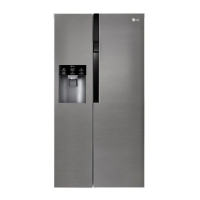Why is my LG Refrigerator vibrating?
- JJohn PetersonSep 4, 2025
To stop your LG Refrigerator from vibrating, ensure that the sides and back do not make any contact with any wall or cabinet.

Why is my LG Refrigerator vibrating?
To stop your LG Refrigerator from vibrating, ensure that the sides and back do not make any contact with any wall or cabinet.
Why is my LG Refrigerator making a rattling noise?
These rattling noises may come from the flow of appliance, the water line on the back of the unit (for plumbed models only), or items stored on top of or around the appliance. If the compressor does not stop rattling after three minutes, turn the power to the appliance off and then on again. Also floor may be weak or uneven or leveling legs need to be adjusted.
Why is my LG Refrigerator not cold enough?
If your LG Refrigerator is not cooling or freezing adequately, try the following: * Set the fridge or freezer temperature to 'Medium'. * Ensure the appliance is not exposed to direct sunlight or near heat sources like ovens or heaters; if it is, relocate it. * Always cool hot foods before refrigerating or freezing them. * Avoid overfilling; maintain space between food items. * Ensure the doors are fully closed and not obstructed by food. * Provide sufficient space around the appliance for proper ventilation.
Why is my LG Refrigerator making a popping noise?
These popping noises are normal. It is caused by the contraction and expansion of the inside walls due to changes in temperature.
Why is my LG Refrigerator making a gurgling noise?
These gurgling noises are normal. It's the sound of the appliance flowing through the cooling system.
Why is my LG Refrigerator making a clicking noise?
These clicking noises are normal. The defrost control clicks when the automatic defrost cycle begins and ends, and the thermostat control clicks when cycling on and off.
Why is my LG Refrigerator so loud?
If your LG Refrigerator is noisy and making abnormal sounds: * Ensure it's installed on a solid, level floor. * Provide clearance between the rear of the appliance and the wall. * Remove any objects behind or on top of the appliance.
Why is it hard to open the LG Refrigerator door?
If you're having trouble opening the door of your LG Refrigerator immediately after closing it, it's likely due to pressure inside the appliance. Wait a few minutes to allow the internal pressure to stabilize before attempting to open it again.
Why is there frost in my LG Refrigerator freezer?
If you find frost in your LG Refrigerator's freezer compartment: * Ensure the door is closing properly and not blocked by food items. * Cool hot foods before storing them. * Ensure that the air entry and exit points in the freezer aren't blocked to allow proper air circulation. * Avoid overfilling the freezer; maintain space between items.
What to do if LG Refrigerator door doesn't close?
To resolve an LG Refrigerator door that won't close tightly: * Adjust the front feet to slightly raise the front. * Ensure shelves are correctly fitted. * Avoid slamming the door; close it gently.
| Control type | Touch |
|---|---|
| Display type | LED |
| Product color | Graphite |
| Product design | American door |
| Built-in display | Yes |
| Shelves material | Tempered glass |
| Appliance placement | Freestanding |
| Star rating | 4* |
| Freezer position | Side-placed |
| Freezing capacity | 12 kg/24h |
| Freezer net capacity | 206 L |
| Freezer gross capacity | - L |
| Freezer number of shelves/baskets | 4 |
| Storage time during power failure | 10 h |
| Fresh zone compartment | - |
| Noise level | 39 dB |
| Climate class | T |
| Total net capacity | 606 L |
| Total gross capacity | 663 L |
| Minimum operating temperature | 16 °C |
| Connected load | - W |
| Energy efficiency scale | A to G |
| Annual energy consumption | 419 kWh |
| Fridge net capacity | 400 L |
| Fridge number of shelves/baskets | 6 |
| Package weight | 128000 g |
| Depth | 717 mm |
|---|---|
| Width | 912 mm |
| Height | 1790 mm |
| Weight | 117000 g |
Essential safety guidelines to prevent risks and damage from unsafe or incorrect operation.
Guidelines for safely disposing of the old appliance according to WEEE regulations.
Specifies required distances from adjacent walls for optimal appliance performance.
Details the appliance's operating temperature range based on climate class.
Requirements and steps for connecting the water supply for dispenser/icemaker.
Procedures for ensuring the appliance is level and doors are aligned properly.
Safe procedures for moving the appliance, including securing parts and transport.
Overview of the appliance's exterior and interior parts and their functions.
Important usage guidelines, energy saving tips, and food storage best practices.
How to use the control panel, dispenser, icemaker, and Door-in-Door system.
Humidity control for vegetable drawer, door alarms, and failure detection.
Using the LG ThinQ app to communicate with the appliance via smartphone.
Using the Smart Diagnosis feature for appliance troubleshooting and usage tips.
Method for diagnosing issues using audible tones via smartphone.
General guidelines and precautions for cleaning the appliance's interior and exterior.
How to replace the Pure N Fresh filter when indicated.
How to clean the dispenser tray and water/ice outlet.
Guide for replacing the water filter, including safety and reset procedures.